Monday, January 24, 2011
Etcetera | bean counting interruptions
I've been a bad blogger, I know. But I ask that you kindly excuse my brief delinquency--I'm working hard to finish blogging about 2010 culinary adventures and to begin drafting 2011 ones! Things have started to pick up again in the bean counting world, like really pick up, as it's our busiest season now. Hopefully I'll be able to find a lot more downtime than I anticipate to grace you with some gastronomical wonders. For now, just cut me a little slack--it's the bean counting world that helps finance this crazy dining lifestyle of mine.
Monday, January 10, 2011
Dinner | Inakaya
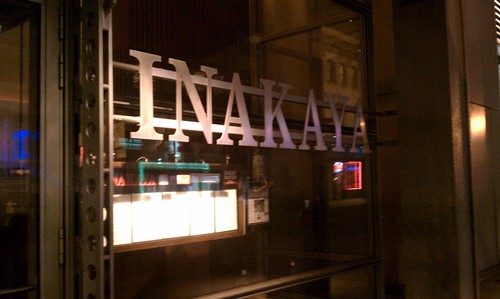
One night in December, Marcus surprised me with a dinner at Inakaya, located on the south side of The New York Times Building on 40th Street.
When we arrived inside, the mâitre d' asked us whether we wanted to be seated at the counter or at a table. We opted for the counter, as the whole restaurant centered on what appeared to be a robata-yaki grill. The first time I had seen one was back in Hong Kong, when I made a visit to Zuma, located in The Landmark shopping center in Central, a trendy Japanese hotspot. It had the typical sushi bar counter, but along with it, Zuma had a robata grill, where quality meats, fish, and vegetables would be grilled to order over robata charcoal. I didn't really think much of it at the time, probably because it was placed in a modern setting. Another noticeable aspect of the restaurant is there is a lot of shouting exchanges in Japanese between the robata chefs and the restaurant's servers--so expect lots of excitement during any future visit to Inakaya!

This is what the robata-yaki counter looks like at Inakaya. I wish I could've had my DSLR handy, but alas, this lovely surprise had to do without it. I admit that my HTC Incredible camera phone doesn't do the space much justice, but it'll have to do for this post! Anyway, the restaurant's menu offered a brief background about the origins of robata-yaki. Robata is Japanese for "around a sunken hearth," and yaki means "grilling." Families used to gather around the hearth for dinner, eventually evolving into robata-yaki style cuisine, where fresh ingredients are cooked on an open flame for those sitting around to observe. At Inakaya, the counter guests are like those surrounding the hearth, with each of the three robata chefs kneeling in front of a grill and flame. Also, ingredients listed on the menu are displayed surrounding the robata cooking area over ice.

As a mushroom fanatic, I made sure we started with an order of enoki mushrooms, robata-yaki style. Enoki mushrooms have this nice balance of crunch and chewiness that can only be explained or understood having eaten them before. The robatayaki preparation had this nice smokey, grill flavor which maintained the main essence and flavor of the mushrooms. Very organic and earthy.
Marcus and I saw kinmedai (Japanese for golden eye snapper) available on the robata grill menu--the same type of fish we had tried for the first time at 15 East, the one where the sushi chef used a blow torch to sear the fish's skin. The menu described it to be a "large and premium pole-and-line fished snapper from Japan". It also mentioned that it is served as a whole fish, grilled with sea salt on the robata grill. While we were contemplating the kinmedai, we also saw the robata chefs serve the couple sitting next to us at the counter the actual whole kinmedai! It looked beautifully crisp and pretty sizable, that is, to be shared between two people. However, when we saw that the listed menu price was M/P (i.e., based on market price), we weren't sure what price range to even expect. After consulting with our waiter about the price (a whopping $130, to our dismay), we decided to go for it, with the same rationale as we had with the white truffle burger from B&B.

Here is the robata chef preparing our kinmedai to be grilled.
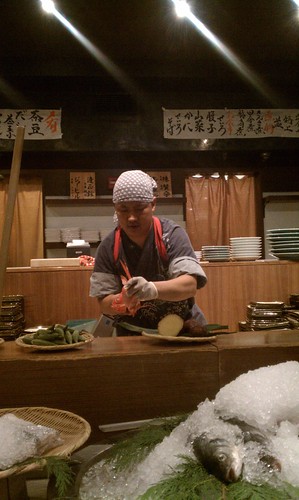
Looks like he's cleaning it and then seasoning it with sea salt! When the snapper was seared and ready to be served, the robata chef placed the dish on a long wooden spatula (which resembled a pizza peel to remove hot pies and slices from pizzeria ovens) in order to hand it to our waiter, who in turn served it to us.

So here's the freshly grilled kinmedai from the robata grill at Inakaya! Notice this fish actually does have a "golden eye" as described in its Japanese name. The skin was really crispy, well-seasoned, and not at all oily, while the meat from the fish was very moist and tender. We barely even had to do much work to get pieces of kinmedai onto our plates from the whole fish--the texture and richness sat on tongues as the pieces of fish melted slowly in our mouths. The combination of the crispy skin and the savoriness of the kinmedai was absolutely delicious and perfect for a dinner to be shared by two people. I really liked the clean and simple flavors (fresh whole fish along with the simple seasoning of sea salt as well as the robata-yaki grilling technique), making for an enjoyable experience. And besides, no one can't beat that kind of presentation!

The "damage" after eating every late bite of the whole kinmedai!
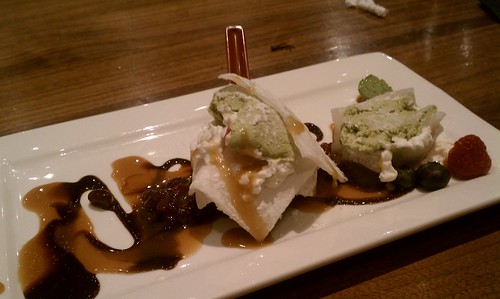
We ended the meal with layered mochi ice cream for dessert, which consisted of green tea ice cream, layered with flat layers of mochi, (i.e., Japanese rice cake made of glutinous rice pounded into paste and molded into shape), drizzled with chocolate sauce. I found this dessert to be a refreshing finish to a very flavorful dinner!
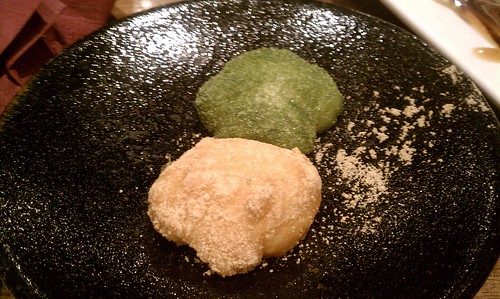
And as an additional treat, the restaurant served us two pieces of fresh mochi (green tea flavor in green and soy bean flavor in beige). These pieces of fresh mochi were prepared by selected restaurant guests in the traditional manner called mochitsuki, which used to be essential in celebrating the Lunar New Year. Mochitsuki was seen as an auspicious gesture that signifies hope for a happy and bright year ahead. The resulting mochi from this process (called kagami-mochi or okasane) was typically made as an offering to the kani (i.e., the deity), comprised of two mochi cakes (like in the photograph below) usually placed on a sheet of pure white paper in the center of a wooden tray.
This traditional mochi-pounding ceremony in Japan has three steps. The first involves soaking polished glutinous rice soaked overnight and cooked. Then, the cooked rice is pounded with a kine (i.e., wooden mallets) in an usu (i.e., a traditional Japanese mortar). Two people alternate the work, one pounding and the other turning and wetting the mochi, while importantly maintaining a steady rhythm to avoid accidentally injuring one another with the heavy kine. After the pounding process, the stick mass is then formed into various shapes (typically a sphere or cube).
So while we were eating our dessert, there were individuals pounding away, near the window of the restaurant, at an usu, each using a kine, alternating at each turn, shouting things in Japanese. We had no idea what they were doing until the server came by with a dish of mochi cakes for each of us. Marcus and I really enjoyed both flavors of mochi very much (though Marcus was a little more partial to the green tea flavor)--they had a fresh chewiness to them, and the flavoring on the outside added some depth as well.
Findings: I love it when I find a restaurant that is authentic as the cuisine comes. The set-up of the robata grill and the incorporation of mochitsuki definitely adds a nice panache to what would have been another neighborhood-y Japanese restaurant. The spirited nature of Inakaya also contributes to its welcoming environment--there's lot of lively, cheerful exchanges between robata chef and restaurant server as well as when guests participate in mochitsuki. It is also really fun when you get to watch someone prepare your dinner, right before your eyes, from seasoning to dinner service, especially on an open flame. So if you're looking for some place very different than what you may have experienced at a neighborhood sushi bar, I would strongly consider making a visit to Inakaya. The splurge on the kinmedai was a quite a bit, but I think it was totally worth it and definitely worth the experience. I'd love to return back here to try the other side vegetable dishes (they had a very wide selection of popular Japanese vegetables) as well as other fish offered on the menu that doesn't hurt the wallet too much.
Price point: market price ($130 during our visit) for a whole kinmedai (robata-yaki style), $8 for dessert.
--December 14, 2010
Inakaya
231 West 40th Street
New York, NY 10018
http://www.inakayany.com
Wednesday, January 5, 2011
Book Signing | Joanne Chang
After watching an episode of Throwdown! with Bobby Flay featuring sticky buns from Joanne Chang's Flour Bakery + Cafe in Boston, I immediately told myself that I needed to make a stop there whenever I found myself in the historic city. I went there two years ago with a bunch of college friends to visit graduate schools, and I absolutely fell in love. The pastries were perfectly scrumptious (Ms. Chang's signature "sticky-sticky buns" lived up to all that hype and then some), and the cafe offerings (I tried a portobello melt and a cup of mushroom barley soup with sweet Italian sausage) used really fresh ingredients and flavors, adding a wonderful homemade feel to them. I've been meaning to go back ever since, so when I found out Ms. Chang had a new cookbook out (one showcasing her bakery's lovely and mouthwatering offerings) and was coming to NYC to sign books, I was totally on it!
Ms. Chang was actually a Harvard alumna who graduated with a degree in Applied Mathematics and Economics. While studying at Harvard, she discovered a dormant penchant for baking. She would bake for friends during study breaks and sell cookies to a local campus cafe. After graduation, she worked at a consulting firm for a couple years, then deciding to drop everything and become a chef/baker. After gaining experience in Boston at Biba and Bentonwood, she moved onto Rialto in Cambridge and then finally to the Big Apple to work for Francois Payard! After spending a year at Payard, Ms. Chang decided to move back to Boston to begin planning to open her own bakery (now Flour). During the planning stages, she took a job at Boston's popular hotspot, Mistral. Two years later, Flour came to be, and subsequently two more locations!
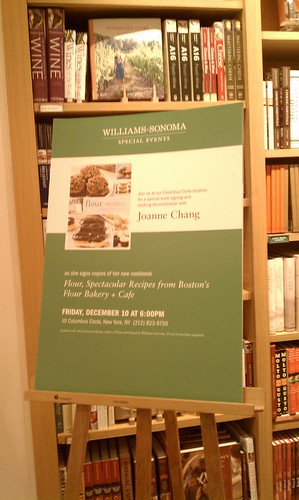
Now with all that background, let's head back to the book signing that night! I asked Marcus to come with me, as we had seen the episode on Food Network together when we first started dating (it was my second time viewing the episode :D). We got there a little early and found her setting up a demonstration at the store for a recipe from her new cookbook!

Per usual, Williams-Sonoma had a bunch of the featured cookbooks displayed along with "related" culinary wares! Notice the copy of the book at the top is opened to the page with Ms. Chang's featured demonstration that night, homemade oreos (located on page 134-135).

Ms. Chang starting her homemade oreo demonstration in the Williams-Sonoma kitchen area.
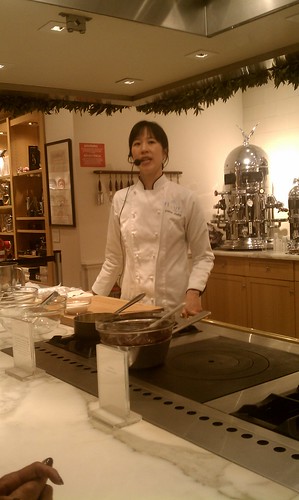
Along with the general demonstration on how to make homemade oreos, Ms. Chang made some really interesting points:
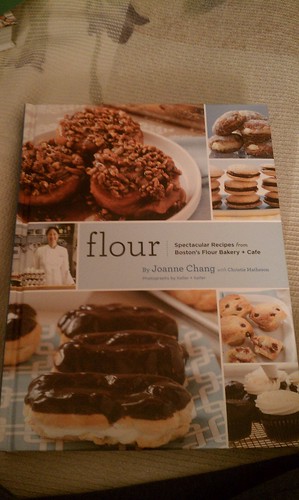
My copy of Flour: Spectacular Recipes from Boston's Flour Bakery + Cafe.

I got to meet Ms. Chang at the end of the demonstration, when she was signing books for attendees. She's so exuberant and eager--everything you need to be a baker! So here's my signed copy: "Eat dessert first!" she wrote--love it!
Findings: Growing up in a Chinese family, I can definitely relate to Ms. Chang's diving head first into baking, especially finding new ways to create nostalgic childhood treats. My mom never baked anything with me while I was growing up. In fact, the first time we baked anything together was when I was home from college! All of my family's weekly meals at home would also be punctuated with fruits (mostly oranges), and on special occasions, a small helping of ice cream. I find her to be such an inspiration--steering the opposite direction from her technical Ivy League degree towards the kitchen takes lots of courage and confidence. I hope one day I can find it in me to trade in my calculator for a toque and an apron! Either way, I'm excited to start making the treats from this book. Her tips from the demonstration were very enlightening and helpful, so I gather her cookbook will do the same. So if you're ever in the Boston area, please make a stop at one of Flour's locations--you won't regret it!
Price point: $35 for each book.
--December 10, 2010
Williams-Sonoma
Time Warner Center
10 Columbus Circle, Suite 114
New York, NY 10019
http://www.williams-sonoma.com/recipe/tip/book-signing-events.html
Flour: Spectacular Recipes from Boston's Flour Bakery + Cafe
Joanne Chang
available here at Amazon.com
at Amazon.com
Ms. Chang was actually a Harvard alumna who graduated with a degree in Applied Mathematics and Economics. While studying at Harvard, she discovered a dormant penchant for baking. She would bake for friends during study breaks and sell cookies to a local campus cafe. After graduation, she worked at a consulting firm for a couple years, then deciding to drop everything and become a chef/baker. After gaining experience in Boston at Biba and Bentonwood, she moved onto Rialto in Cambridge and then finally to the Big Apple to work for Francois Payard! After spending a year at Payard, Ms. Chang decided to move back to Boston to begin planning to open her own bakery (now Flour). During the planning stages, she took a job at Boston's popular hotspot, Mistral. Two years later, Flour came to be, and subsequently two more locations!

Now with all that background, let's head back to the book signing that night! I asked Marcus to come with me, as we had seen the episode on Food Network together when we first started dating (it was my second time viewing the episode :D). We got there a little early and found her setting up a demonstration at the store for a recipe from her new cookbook!

Per usual, Williams-Sonoma had a bunch of the featured cookbooks displayed along with "related" culinary wares! Notice the copy of the book at the top is opened to the page with Ms. Chang's featured demonstration that night, homemade oreos (located on page 134-135).

Ms. Chang starting her homemade oreo demonstration in the Williams-Sonoma kitchen area.

Along with the general demonstration on how to make homemade oreos, Ms. Chang made some really interesting points:
- Flour Bakery stresses the use of real butter and chocolate.
- The touchstone of Flour Bakery and its new cookbook features nostalgic recipes (as many of the bakery's offerings are Ms. Chang's take on the universal American treats (e.g., Oreos, s'mores, Pop Tarts, etc.), that is, childhood desserts recreated. She mentioned how she grew up in a traditional Chinese family, where she "rarely had a chance to indulge her sweet tooth at all" as most Chinese meals tend to end with nothing really sweet--usually orange slices and other assorted fruits.
- She also talked about how she loves to use unsalted butter when she bakes. Salt is used as a preservative, which means that the salted butter you get in stores may be older than desired. Because the salt content of the butter varies from manufacturer to manufacturer, the product itself is inconsistent. Ms. Chang likes to add her own salt (i.e., kosher salt--the "chef's salt") to recipes, noting that if you'd like to use regular salt instead of kosher salt, you would just tweak her recipes to half the required amount.
- My favorite part of her demonstration was how she described vanilla to have a "rounding" effect, salt to have a "sharpening" effect, and chocolate to have a "sweetening" effect on baking, respectively. I can't seem to explain why, but I totally follow that train of thought!
- Throughout her demonstration, she gave little tips on how to execute her homemade oreo recipe smoothly (e..g, how to make the oreo cookie dough round, using salt, whisking techniques, making your own pastry bag for icing/frosting using a Ziploc bag, etc.).

My copy of Flour: Spectacular Recipes from Boston's Flour Bakery + Cafe.

I got to meet Ms. Chang at the end of the demonstration, when she was signing books for attendees. She's so exuberant and eager--everything you need to be a baker! So here's my signed copy: "Eat dessert first!" she wrote--love it!
Findings: Growing up in a Chinese family, I can definitely relate to Ms. Chang's diving head first into baking, especially finding new ways to create nostalgic childhood treats. My mom never baked anything with me while I was growing up. In fact, the first time we baked anything together was when I was home from college! All of my family's weekly meals at home would also be punctuated with fruits (mostly oranges), and on special occasions, a small helping of ice cream. I find her to be such an inspiration--steering the opposite direction from her technical Ivy League degree towards the kitchen takes lots of courage and confidence. I hope one day I can find it in me to trade in my calculator for a toque and an apron! Either way, I'm excited to start making the treats from this book. Her tips from the demonstration were very enlightening and helpful, so I gather her cookbook will do the same. So if you're ever in the Boston area, please make a stop at one of Flour's locations--you won't regret it!
Price point: $35 for each book.
--December 10, 2010
Williams-Sonoma
Time Warner Center
10 Columbus Circle, Suite 114
New York, NY 10019
http://www.williams-sonoma.com/recipe/tip/book-signing-events.html
Flour: Spectacular Recipes from Boston's Flour Bakery + Cafe
Joanne Chang
available here
Sunday, January 2, 2011
Lunch | Grimaldi's Pizzeria
Walking across the Brooklyn Bridge has been something I've wanted to do in the city for the longest time, and now that I had someone to walk with (Marcus, of course), I could do it sooner! Marcus and I decided to wait until the weather cooled down from the heavy summer heat to nice and slightly chilly fall weather. Early November seemed to have been the best time for that. I've also been meaning to try that famous pizza place in DUMBO (i.e., Down Under the Manhattan Bridge Overpass) near the end of the Brooklyn Bridge on the Brooklyn side. I found out it's called Grimaldi's Pizzeria.

It was quite chilly that Saturday morning in November, but the sunny weather helped to counter the cold air. Luckily, it wasn't too windy either, so our walk was very pleasant.

Photograph of the first tower!

View of Manhattan from the Brooklyn Bridge.

Me on the Brooklyn Bridge pedestrian walkway.

At the middle of the Bridge.

And we made it over in 25 minutes! I love this sign--"Welcome to Brooklyn--How Sweet It Is!"

We made it to Grimaldi's around 1 PM.
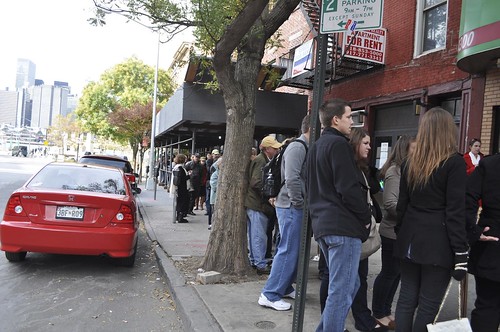
And here was the line at that time.

And just some information in case you plan on making a stop here--it's pies and cash only! Also, many people order take-out for pick-up so the wait isn't so brutal, but when the sign outside reads what it says above, you'll have to stand in line with the rest of the eager pizza eaters.

After waiting about 45 minutes in the cold, we finally made it inside the pizzeria. As you can see, it's located in a very modest-sized space, but don't let that fool you. The turnover is very quick!

The tables ladened with red checkered picnic-style table cloths, making for a very relaxed and homey environment.

The guys working the pizzeria's magic, churning out pies like a factory conveyor belt!

Marcus and I ordered a large (16-inch) pie with mushroom and pepperoni (an order of 8 slices). The medium pie was only 2 inches smaller in diameter, and since the large-sized pie was only $2 more, an additional two more slices was well worth it.
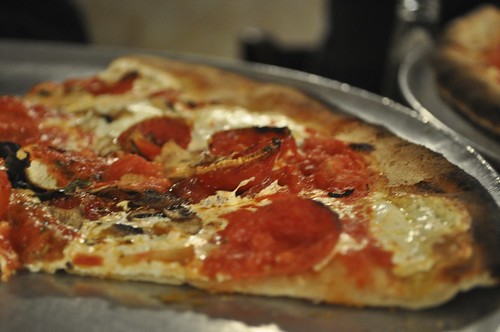
The pizza from Grimaldi's is a coal-fired in a brick oven, which gives the pizza a nice smokey flavor as well as an extra crispy crust. I also liked that the slices were thin, so we could eat more pizza without the worry of filling up on too many carbohydrates in two slices. Grimaldi's uses fresh mozzarella, crushed tomato, and basil in its original pizza pie (as opposed to its white pizza pies which have no tomato but is compensated with extra cheese and fresh garlic).
The mushrooms on our pie were sliced thin, which I really liked because the slices were not at all soggy. Mushrooms typically release moisture as they're being cooked, so ordering them as pizza toppings can lead to soggy pizza if they're fresh mushrooms sliced thickly. Anyway, while mushrooms remain my overall favorite pizza topping, the pepperoni from Grimaldi's takes the cake. As seen in the above photograph, the pepperoni toppings are smaller in diameter and thicker in slice than the ones I'm used to seeing. They even curled up like suction cups! Being so, we were able to get the hearty pepperoni flavor from the thicker slices and were somehow less greasy. The circumferences of the pepperoni (i.e., the part that flipped up into a suction cup shape) were crisp and toasted, giving the topping an added dimension of smokey flavor (mostly resembling really crispy bacon right off the skillet). Additionally, the dough used in creating these pies are light, so the dough portion of the pizza didn't seem to fill up as quickly as it normally would.
Findings: I really enjoyed the walk over the Brooklyn Bridge! DUMBO seems to have a lot of food hotspots worth visiting--I'd definitely love to go back when it gets warmer to pay a visit to the Brooklyn Ice Cream Factory and DUMBO's General Store. Anyway, Grimaldi's made for a really good lunch to look forward to after trekking across the Bridge into DUMBO from Manhattan. I think the value you get for the price is well worth the trip! A thin crust, smokey flavor, fresh pizza ingredients, and quality toppings--can't go wrong with those with regards to pizza! I would advise going earlier to avoid lines or ordering take-out to eat outside on a nice day. This makes for a great place to take out-of-town guests as you can entertain them with some sightseeing and some authentic New York pizza. I look forward to making another visit this coming spring!
Price point: $14 for a large regular pizza, $2 each for pepperoni and mushrooms.
--November 6, 2010
Grimaldi's Pizzeria
19 Old Fulton St
Brooklyn, NY 11201
http://www.grimaldis.com

It was quite chilly that Saturday morning in November, but the sunny weather helped to counter the cold air. Luckily, it wasn't too windy either, so our walk was very pleasant.

Photograph of the first tower!

View of Manhattan from the Brooklyn Bridge.

Me on the Brooklyn Bridge pedestrian walkway.

At the middle of the Bridge.

And we made it over in 25 minutes! I love this sign--"Welcome to Brooklyn--How Sweet It Is!"

We made it to Grimaldi's around 1 PM.

And here was the line at that time.

And just some information in case you plan on making a stop here--it's pies and cash only! Also, many people order take-out for pick-up so the wait isn't so brutal, but when the sign outside reads what it says above, you'll have to stand in line with the rest of the eager pizza eaters.

After waiting about 45 minutes in the cold, we finally made it inside the pizzeria. As you can see, it's located in a very modest-sized space, but don't let that fool you. The turnover is very quick!

The tables ladened with red checkered picnic-style table cloths, making for a very relaxed and homey environment.

The guys working the pizzeria's magic, churning out pies like a factory conveyor belt!

Marcus and I ordered a large (16-inch) pie with mushroom and pepperoni (an order of 8 slices). The medium pie was only 2 inches smaller in diameter, and since the large-sized pie was only $2 more, an additional two more slices was well worth it.

The pizza from Grimaldi's is a coal-fired in a brick oven, which gives the pizza a nice smokey flavor as well as an extra crispy crust. I also liked that the slices were thin, so we could eat more pizza without the worry of filling up on too many carbohydrates in two slices. Grimaldi's uses fresh mozzarella, crushed tomato, and basil in its original pizza pie (as opposed to its white pizza pies which have no tomato but is compensated with extra cheese and fresh garlic).
The mushrooms on our pie were sliced thin, which I really liked because the slices were not at all soggy. Mushrooms typically release moisture as they're being cooked, so ordering them as pizza toppings can lead to soggy pizza if they're fresh mushrooms sliced thickly. Anyway, while mushrooms remain my overall favorite pizza topping, the pepperoni from Grimaldi's takes the cake. As seen in the above photograph, the pepperoni toppings are smaller in diameter and thicker in slice than the ones I'm used to seeing. They even curled up like suction cups! Being so, we were able to get the hearty pepperoni flavor from the thicker slices and were somehow less greasy. The circumferences of the pepperoni (i.e., the part that flipped up into a suction cup shape) were crisp and toasted, giving the topping an added dimension of smokey flavor (mostly resembling really crispy bacon right off the skillet). Additionally, the dough used in creating these pies are light, so the dough portion of the pizza didn't seem to fill up as quickly as it normally would.
Findings: I really enjoyed the walk over the Brooklyn Bridge! DUMBO seems to have a lot of food hotspots worth visiting--I'd definitely love to go back when it gets warmer to pay a visit to the Brooklyn Ice Cream Factory and DUMBO's General Store. Anyway, Grimaldi's made for a really good lunch to look forward to after trekking across the Bridge into DUMBO from Manhattan. I think the value you get for the price is well worth the trip! A thin crust, smokey flavor, fresh pizza ingredients, and quality toppings--can't go wrong with those with regards to pizza! I would advise going earlier to avoid lines or ordering take-out to eat outside on a nice day. This makes for a great place to take out-of-town guests as you can entertain them with some sightseeing and some authentic New York pizza. I look forward to making another visit this coming spring!
Price point: $14 for a large regular pizza, $2 each for pepperoni and mushrooms.
--November 6, 2010
Grimaldi's Pizzeria
19 Old Fulton St
Brooklyn, NY 11201
http://www.grimaldis.com
Saturday, January 1, 2011
Toasts | Happy 2011!
Just wanted to wish everyone a happy, healthy, and prosperous year ahead on 1.1.11! Looking forward to a year filled with new culinary, gastronomic, and delectable adventures!
Subscribe to:
Posts (Atom)
